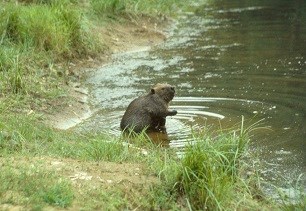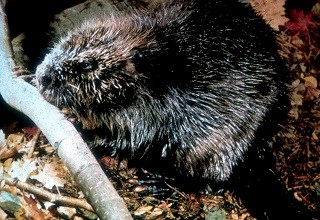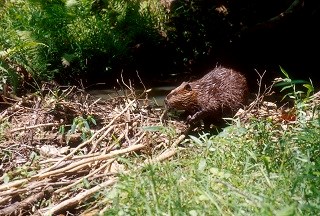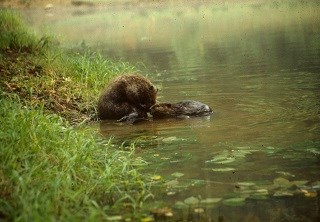|
The beaver is a lumberjack, wildlife conservationist and architect. They are the largest rodent in North America and are easily identified by their flat, black, scaly tail which acts like a rudder when swimming. Beavers also use their tail as a warning system by slapping it on the water to alert other beavers of potential danger. The beaver is designed to live in and around water and they can hold their breath for 15 minutes. 
NPS Photo HabitatLike all rodents, they have continuously growing incisors, which need to be trimmed by gnawing on wood. They are herbivores, eating twigs, leaves, tree bark and water plants. Beavers topple trees in order to construct dams which raises the water level. In this flooded area they build their domelike lodge made of sticks, grasses and mud. The entrances to the lodge are underwater. A good indicator that beavers are living nearby is the prevalence of pointed tree stumps. 
NPS Photo TeethBeaver teeth have a hard orange enamel on the front and a softer enamel on the back, which wears away faster. This creates a chisel-like point to make gnawing through wood extremely efficient. A beaver can gnaw through a five-inch diameter tree in five minutes. They prefer 
NPS Photo HistoryBeavers were the most hunted animal from the 1600s to the 1800s due to their valuable fur. Beaver fur has two layers, a fatty inner layer and an outer layer that is waterproof. This made beaver hats popular with hunters and eventually beaver hats and clothing became fashionable in Europe. As a result, it is estimated that between 60-400 million beavers were trapped and killed in North America. The beaver trade was one of the reasons people spread west and settled this country. 
NPS Photo Other InformaitonBeavers have valves in their ears, nose, and back of their throat to prevent water from seeping into those areas. Their hind feet are webbed and they can swim about 5 mph. Another aquatic adaptation beavers have developed is a nictitating membrane which is a translucent eyelid. It acts like underwater goggles, allowing beavers to see as well on land, as under water. |
Last updated: November 13, 2023
